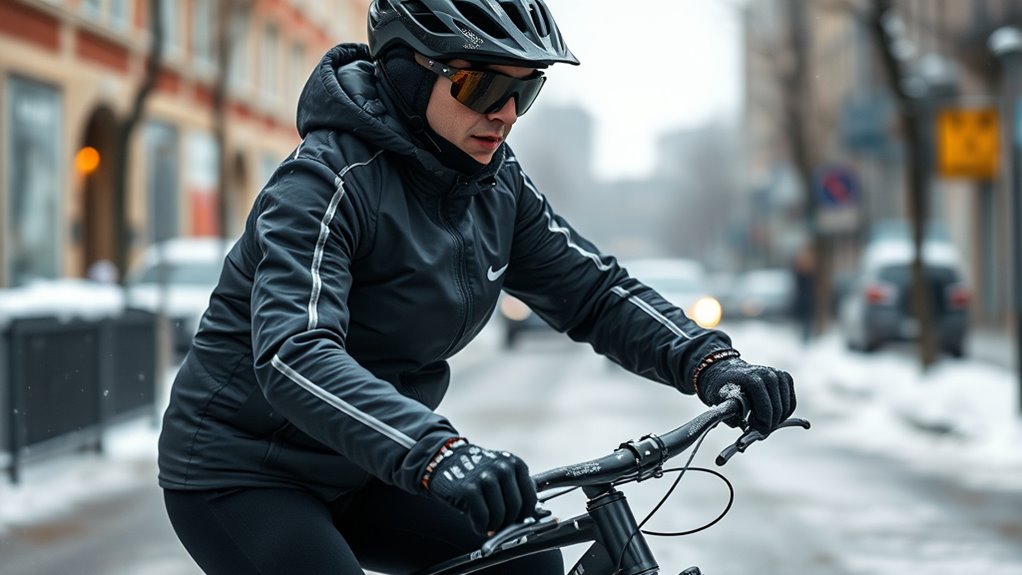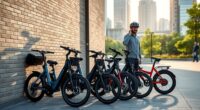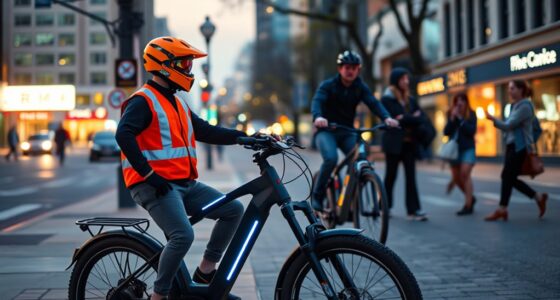To layer effectively for winter e-bike commuting, start with moisture-wicking base layers to keep sweat away and prevent chills. Add an insulating layer like fleece or a lightweight down jacket for warmth, and top with a waterproof outer shell for protection against wind and snow. Wear thermal gloves, a helmet liner, and a neck gaiter for extra cold-weather defense. Make certain visibility with reflective gear and lights. Proper layering boosts comfort and safety—keep exploring for more tips to stay prepared.
Key Takeaways
- Start with a moisture-wicking base layer to keep sweat away and prevent chills during rides.
- Add an insulating layer like fleece or lightweight down for warmth without restricting movement.
- Use windproof and waterproof gloves, hats, and neck gaiters to protect extremities from cold and wet conditions.
- Incorporate reflective and high-visibility gear, including vests, strips, and proper lighting, for safety in low-light environments.
- Layer versatile, adjustable protective accessories to adapt quickly to changing weather and ensure comfort and safety.

Winter e-bike commuting requires more than just a warm jacket; it demands a strategic approach to layering protective gear. The key is to stay warm, visible, and safe while steering through cold, often unpredictable conditions. Proper layering ensures you retain body heat, protect sensitive areas, and remain visible to others on the road. Start with a moisture-wicking base layer to keep sweat away from your skin, preventing chills as you ride. Next, add an insulating layer—fleece or a lightweight down jacket—that traps heat. This combination forms the foundation for a comfortable, warm ride.
Your hands are especially vulnerable in winter, so invest in high-quality winter glove insulation. Look for gloves with thermal linings and windproof materials that block cold air from penetrating. Your gloves should allow dexterity so you can operate brakes and gears without difficulty. Remember, no matter how insulated your gloves are, they won’t be effective if they get wet, so choose waterproof options when possible. Layering isn’t just about warmth—it’s about functionality. Consider using touchscreen-compatible gloves to maintain control without exposing your fingers to the cold.
Equally important is visibility. Reflective safety gear should be a staple in your winter riding wardrobe. Wear a reflective vest or jacket over your layers, especially during dawn, dusk, or overcast days. Reflective strips on your helmet, backpack, and bike itself boost your visibility from all angles. When combined with proper lighting—front and rear—reflective gear makes a notable difference in preventing accidents. Visibility isn’t just about being seen; it’s about being recognizable and alerting others to your presence, especially in low-light conditions common during winter months. Additionally, high contrast clothing can significantly improve your visibility in snowy or foggy conditions.
Finally, don’t forget about protecting your head and neck. Wear a thermal helmet liner or a hat under your helmet to add extra insulation. A neck gaiter or scarf made of moisture-wicking, insulating fabric can shield you from cold drafts and wind. Layering your protective gear in this way ensures that you’re not only warm but also prepared for sudden weather changes. The goal is to create a versatile, adaptable system that can be adjusted as needed, so you stay comfortable and safe throughout your winter commute. By focusing on insulating your hands with the right gloves and making yourself highly visible with reflective safety gear, you greatly enhance your winter riding experience.
Frequently Asked Questions
How Do I Prevent My Gear From Freezing or Getting Damp?
To prevent your gear from freezing or getting damp, focus on thermal insulation and moisture management. Wear waterproof and breathable outer layers that keep moisture out while allowing sweat to escape. Use moisture-wicking base layers to draw sweat away from your skin, preventing dampness. Make sure your gear dries quickly and store it properly after rides. This combination keeps you warm, dry, and comfortable during winter commutes.
What Are the Best Materials for Winter Cycling Protection?
You should choose insulation materials like synthetic fibers or wool that trap heat without adding bulk. Waterproof fabrics such as Gore-Tex or nylon with a waterproof coating keep you dry and protect against snow and rain. Look for gear with sealed seams and breathable layers to stay comfortable. Combining these materials guarantees your protection remains effective, warm, and dry during your winter E-bike commute.
How Should I Adjust Gear for Different Winter Weather Conditions?
Considering your gear, you’ll want to adapt to winter wind and snow resistance. Think of it as riding through a different era—adjust your layers based on temperature drops or wind intensity. If it’s windy, add a windproof outer layer; for snow, guarantee your clothing is waterproof and insulated. When the weather clears, lighten up by removing layers, but always keep your core protected for comfort and safety.
Can Layering Affect My E-Bike’s Battery Performance?
Layering your protective gear can impact your e-bike’s battery efficiency, mainly because thermal insulation affects how well your battery stays warm. If you wear bulky, insulated gear, it might trap heat and help keep the battery warmer, improving performance. Conversely, poor insulation can lead to cold batteries, reducing efficiency and range. So, choose layered gear that offers thermal insulation without obstructing airflow or cooling, to keep your battery functioning effectively.
What Are Quick-Drying Options for Winter Cycling Gear?
When it comes to quick-drying options for winter cycling gear, you want to stay ahead of the game. Look for thermal fabrics that dry fast and keep moisture wicking to avoid feeling damp and cold. Materials like synthetic blends or merino wool excel in this area, pulling sweat away from your skin and drying quickly. With the right gear, you can keep riding comfortably without missing a beat, even in chilly conditions.
Conclusion
Just as armor protected ancient warriors, your layered gear shields you from winter’s harshness. By choosing the right combination, you stand resilient against cold and elements, turning your ride into a confident journey rather than a battle. Think of it as a modern-day shield—crafted with purpose, adaptable, and essential. Embrace this layered approach, and ride through winter’s challenges with the poise of a seasoned knight, ready for whatever the season throws your way.









